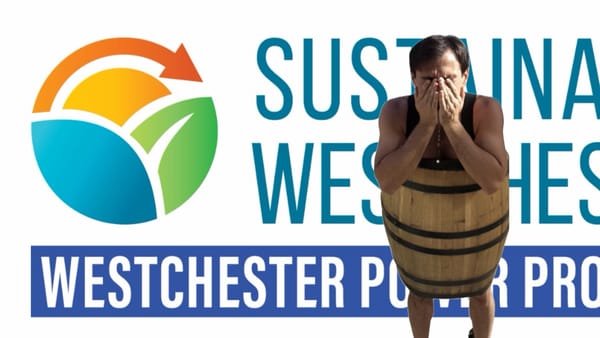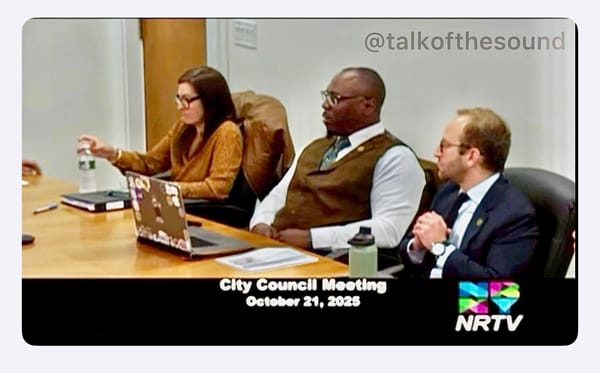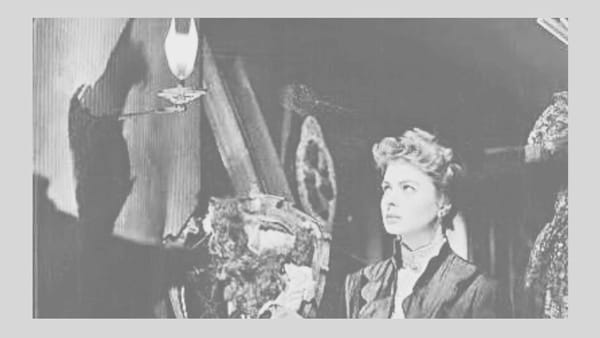Yadira & Co. Gaslighting on New Rochelle’s Flowers Park – Part X
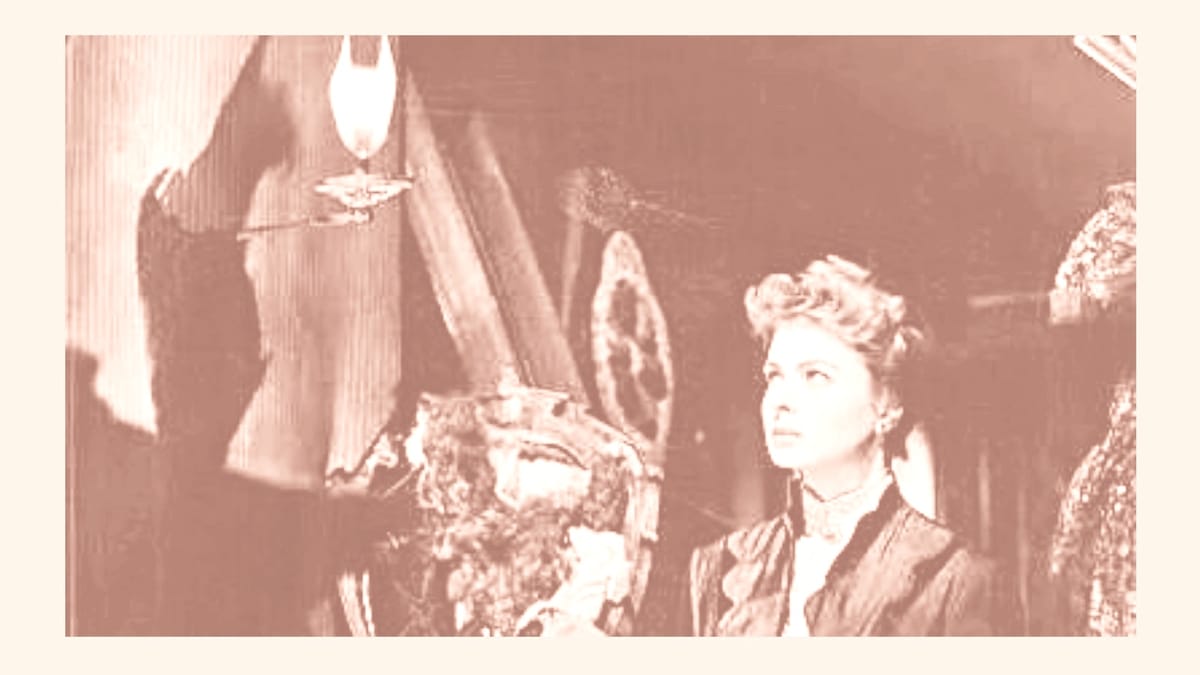
DUBLIN, IRELAND (November 12, 2025) — As the New Rochelle City Council prepares to be put on full-blast at tonight’s Citizens to be Heard, I wanted to throw together a few disparate tidbits to round out my gaslighting series, content I gathered later or new issues and questions that have arisen recently so in no particular order are a few bits and bobs.
Recent Media Coverage
WCBS-TV: Possible redevelopment of a New Rochelle park is prompting significant community outcry
FOX5-TV: Parents rally to stop sale of beloved New Rochelle athletic fields
Lohud: Why are some New Rochelle residents upset about development at Flowers Park? An explainer ($)
Flood Videos
During Melendez’s unauthorized “ambush” presentation on Oct. 21, 2025—which purported to demonstrate that Flowers Park is prone to flooding thus necessitating a public-private partnership to address a problem that doesn’t actually exist—he showed a slide featuring four videos.
They were difficult to view clearly so I requested copies under New York’s Open Meetings Law, obtained them, and compiled the footage into a single video for better accessibility. Here are all four videos in one place:
Flowers Park Renovation Project (2009-2012)
I asked Ken Jenkins’ office to provide me a work plan, a map, and a couple of photos and a few minutes to talk to an engineer to know what the County did back in the day and why but so far no reply. I asked again today.
Many people have raised the issue of the previous renovations of Flowers Park. I have published so many stories over the past two decades I forgot that I wrote about the County project myself about 14 years ago: All-New Fosina Field at City Park Opens in New Rochelle (5/6/2011)
Westchester County was directly involved in funding and partnering on major renovations at Flowers Park (also known as City Park or the William “Brud” Flowers Sports Complex) in New Rochelle around 2009-2012.
City (Flowers) Park History
The park was originally constructed in the 1920s with the first major construction being the stone recreation building in the center of the site. Various improvements have occurred over the years and the most recent projects include the following:
- Constructed Fosina Field and Concession Building (1997)
- Constructed Skidelsky Field (1999)
- Installed lights at the adult softball field (2001)
- Constructed skate park (2006)
- Constructed picnic pavilion (2007)
Flooding Context
- The park, about 20 acres at Fifth and Potter avenues, sits at a low point in the local watershed. Drainage from surrounding areas, including Beechmont Lake, flows through an open stream into a culvert under the park, contributing to flooding issues during heavy rain.
- A 2008 Pine Brook Drainage Study by Dvirka & Bartilucci Consultant Engineers (for the City of New Rochelle) identified the need for better stormwater management. It proposed a 5-acre underground concrete box/vault system under the ball fields capable of storing up to 25 acre-feet of stormwater. This would reduce flows in Pine Brook and the Premium River by 25-27% during storms up to a 10-year event, while also potentially allowing infiltration for water quality benefits.
- The study estimated costs at $10.6 million (in 2008 dollars, or $16 million today) and noted challenges like unknown soil conditions and disruptions to park use. It was referenced in later reports, like Westchester County’s 2013 Stormwater Reconnaissance Plan for the Coastal Long Island Sound Watershed.
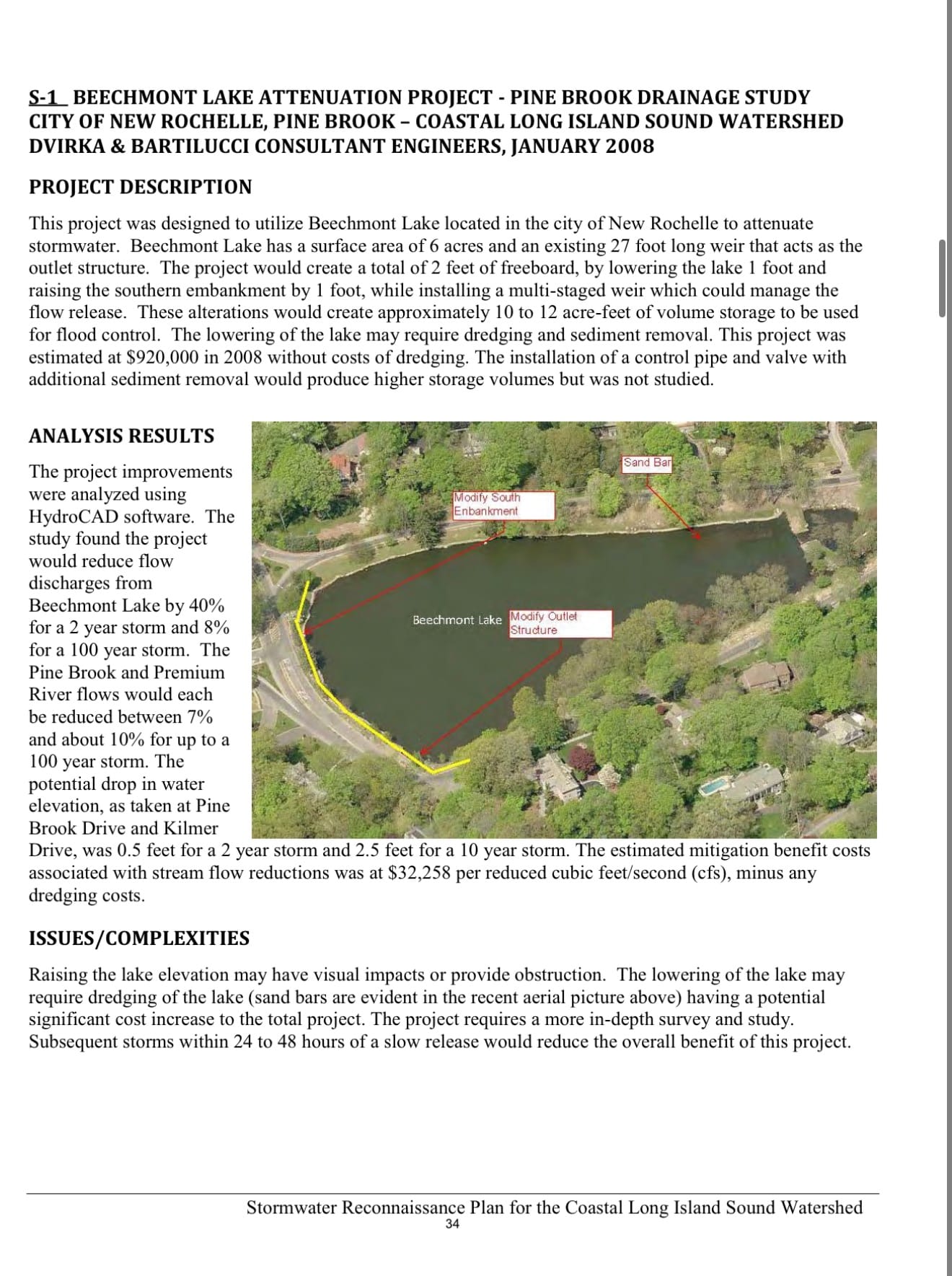
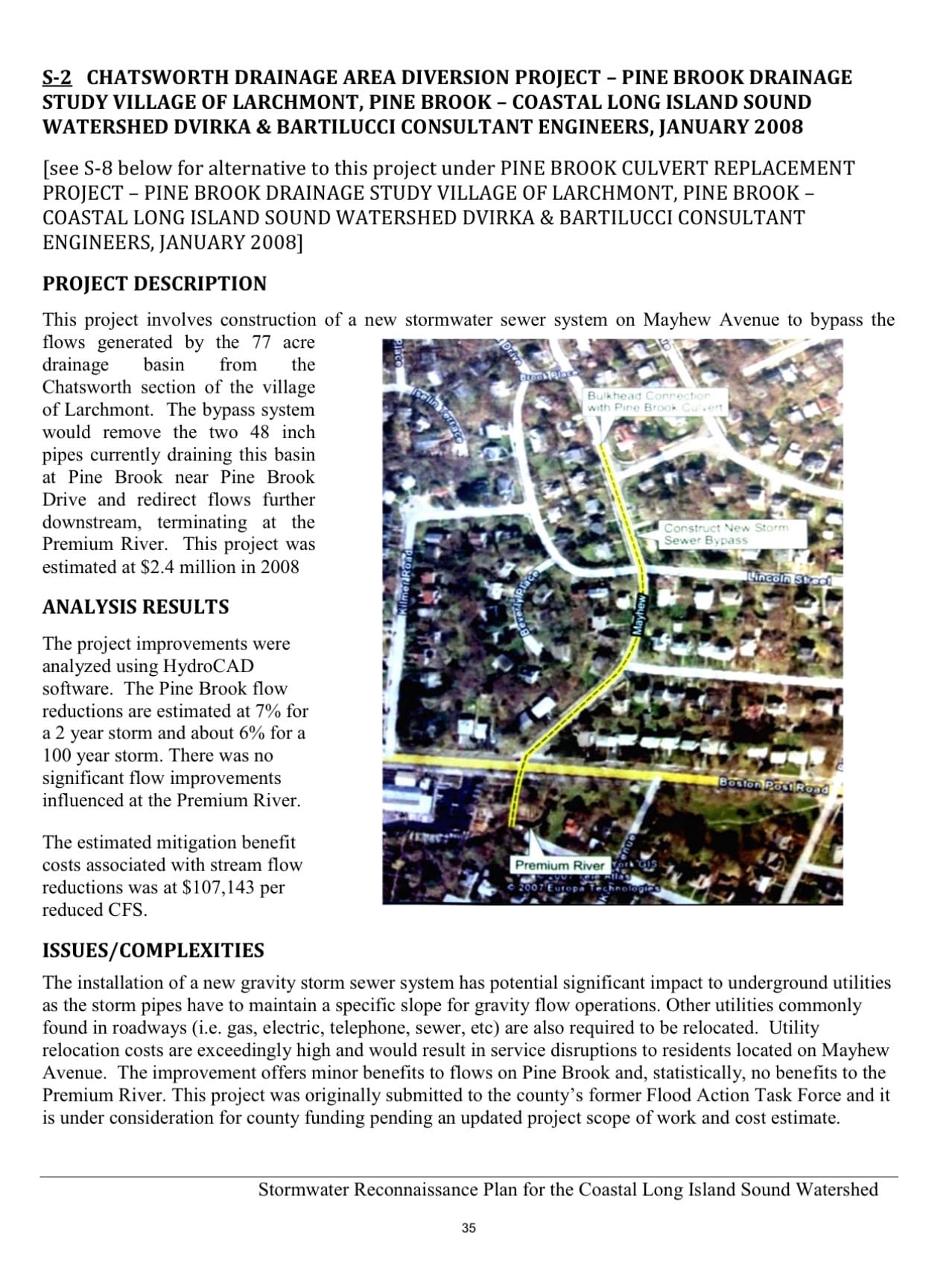
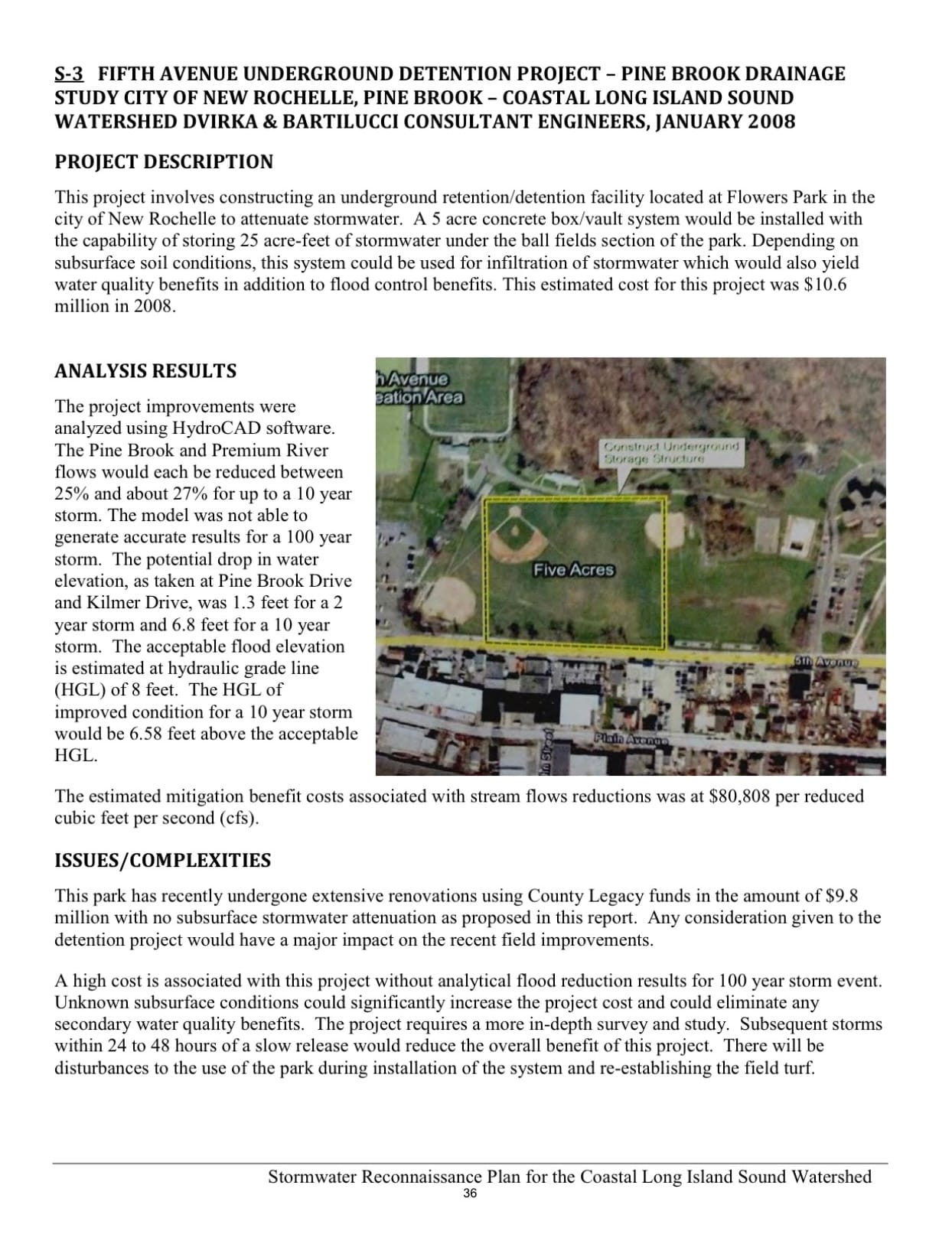
I have gotten mixed information from people that worked for the City or work for the City now that indicate some flood mitigation work was done at the park since 2008 but I don’t have any specific information. The County has not provided anything yet so unless I have a reader who knows the details -and maybe some of the paperwork and even some photographs — I don’t really know what happened in the past 17 years at Flowers Park with projects like this; if you know, please contact me.
Here is what I do know. In 2008, Dvirka & Bartilucci Consultants proposed a 5-acre underground concrete box/vault system under the ball fields capable of storing up to 25 acre-feet of stormwater. In 2011, the City said a goal of the park improvements was improved site drainage which involved excavating the ballfields to install the underground retention/detention facility. In 2013, the County said no subsurface stormwater attenuation as proposed in their 2013 report (a 5-acre underground concrete box/vault system) had been done. They note that any consideration given to the detention project would have a major impact on the 2011 field improvements, that there was a high cost associated with this project without analytical flood reduction results for a 100 year storm event, and that unknown subsurface conditions could significantly increase the project cost and could eliminate any secondary water quality benefits.
Westchester Legacy Program
- Westchester County provided $9.8 million through its Legacy program grants for the upgrades, in partnership with the City of New Rochelle. The city managed the park under an inter-municipal agreement with the county.
- The goal was to create an all-weather athletic complex, with a focus on environmental conservation through improved site drainage. This involved excavating (“ripping up”) the ballfields to install the underground retention/detention facility.
- The project was phased to minimize disruptions:
– Phase I: Replacement of Skidelsky Field (funded partly by FEMA/SEMO).– Phase II: Replacement of Fosina Field (synthetic turf for football, soccer, lacrosse) and a new natural turf softball field.– Phase III: New synthetic turf baseball and softball fields, playground, splash pad (“sprayground”); construction began June 2011, completed June 2012.– Phase IV: Parking lot reorganization and expansion. - The all-new Fosina Field opened on May 6, 2011, marking a key milestone. When fully done in 2012, the park featured five athletic fields, a basketball court, playground, picnic pavilion, skate park, lighting, and passive recreation areas.
Project Benefits
- A flagship athletic facility situated within a serene, park-like setting
- Construction phasing strategically planned to field outages and disruptions to games, events, and ongoing activities
- Enhanced drainage systems designed to handle inclement weather effectively and prioritize environmental conservation
- Improved parking and traffic flow for better accessibility and efficiency
- Increased field usage capacity to support expanded activities
Park Optimization
- Service to a diverse cross-section of youth and adult participants, including more than 25 youth/adult community-based organizations with over 200 teams, New Rochelle School District Athletics, New Rochelle private schools, College of New Rochelle, Iona College, Monroe College, and the city’s Parks and Recreation youth/adult programs
- High-quality athletic fields with sensible configurations that allow multiple sports activities to occur simultaneously
- New synthetic turf surfaces enabling increased usage, including play during or immediately following inclement weather
- Sports athletic field lighting to extend daily usage potential into evening hours
- Incorporation of passive recreation areas within the park’s natural settings
- Water playground and basketball court areas designed to promote free, healthy, and recreational play for all ages
Quotes from Involved Parties
- Westchester County Executive Robert P. Astorino: “Fosina Field is a welcome addition to the great variety of recreational fields in our county. This park will become a great destination for athletes and fans. With the addition of playgrounds, hiking trails and basketball there will be something for everyone to do. I thank the Board of Legislators for its support of this project, as well as our partners in the City of New Rochelle.”
- County Legislator James Maisano: “This was a terrific county/city effort, and when the work is completed, New Rochelle’s kids will have one of the finest athletic facilities in the county. Everyone worked together in a bi-partisan way to put New Rochelle’s kids first, and this project will improve our community for decades.”
- County Legislator Sheila Marcotte: “This brand new field will now be able to endure countless games and be enjoyed by many. The success of this Legacy program can be measured by the smiles of the children who will happily, and safely, call this their home field.”
- County Legislator Judy Myers: “Once again, Westchester County’s innovative Legacy program has proven its worth. The opening of this field adds onto the number of athletic fields open to all residents of Westchester County and is a very welcome addition in particular to this southern area of the county that has too few fields and too little open space.”
- New Rochelle Mayor Noam Bramson: “Once City Park is fully completed, this flagship athletic facility will provide recreational opportunities for thousands of residents, including more than 25 community-based organizations with over 200 teams, as well as our local schools and colleges. This outstanding legacy project is proof that even in challenging times we can come together to accomplish big things for the people of New Rochelle and Westchester County.”
- Joe Fosina (field namesake): “The whole Youth Tackle League program, both coaches and staff, are excited about this field. We look forward to August, and the start of our season. It was a labor of love for most of us, and it’s just beautiful.”
Pinebrook Watershed Town Hall
In 2023, engineers hired by New Rochelle (operating under then-DPW Commissioner Will Melendez) held a series of town hall meetings to explain the Drainage Analysis begun in 2022 in the wake of Hurricane Ida in 2021. A total of six drainage basin areas were reviewed: Burling Brook, Hutchinson, Pinebrook, Sheldrake River, Shoreline, and Stephenson Brook. The Pinebrook Watershed Town Hall was held on Wednesday, March 22, 2023.
Brooker Engineering gave an overview of the process at City Hall in the Council Chambers. I was unable to locate any videos or other records from these 2023 sessions but I did find a version of the Pine Brook watershed presentation from 2024 which I understand is basically the presentation that was presented the year before, so in the absence of anything better, I’m presenting this here but if I come up with the actual 2023 presentation with the correct date on it, I will certainly swap it out here. Let me go with what I have.
Flowers Park is mentioned briefly but nothing that identifies the park as high risk:
- North side of park is adjacent to three steep hills that descend southernly into the park
- Much of the park is situated on flat, low-lying land
- Information on the existing infrastructure within Flowers Park is sporadic and incomplete
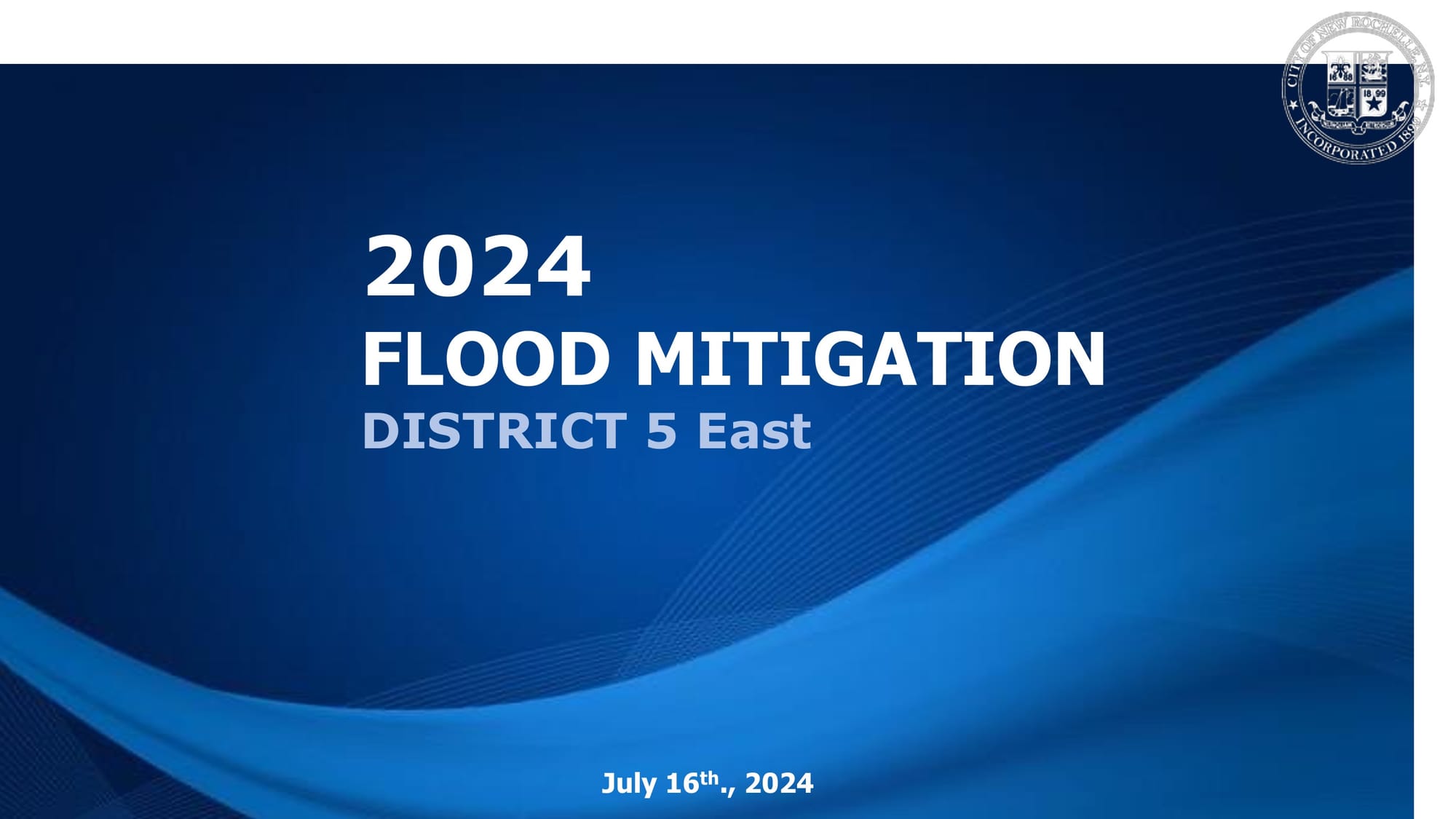
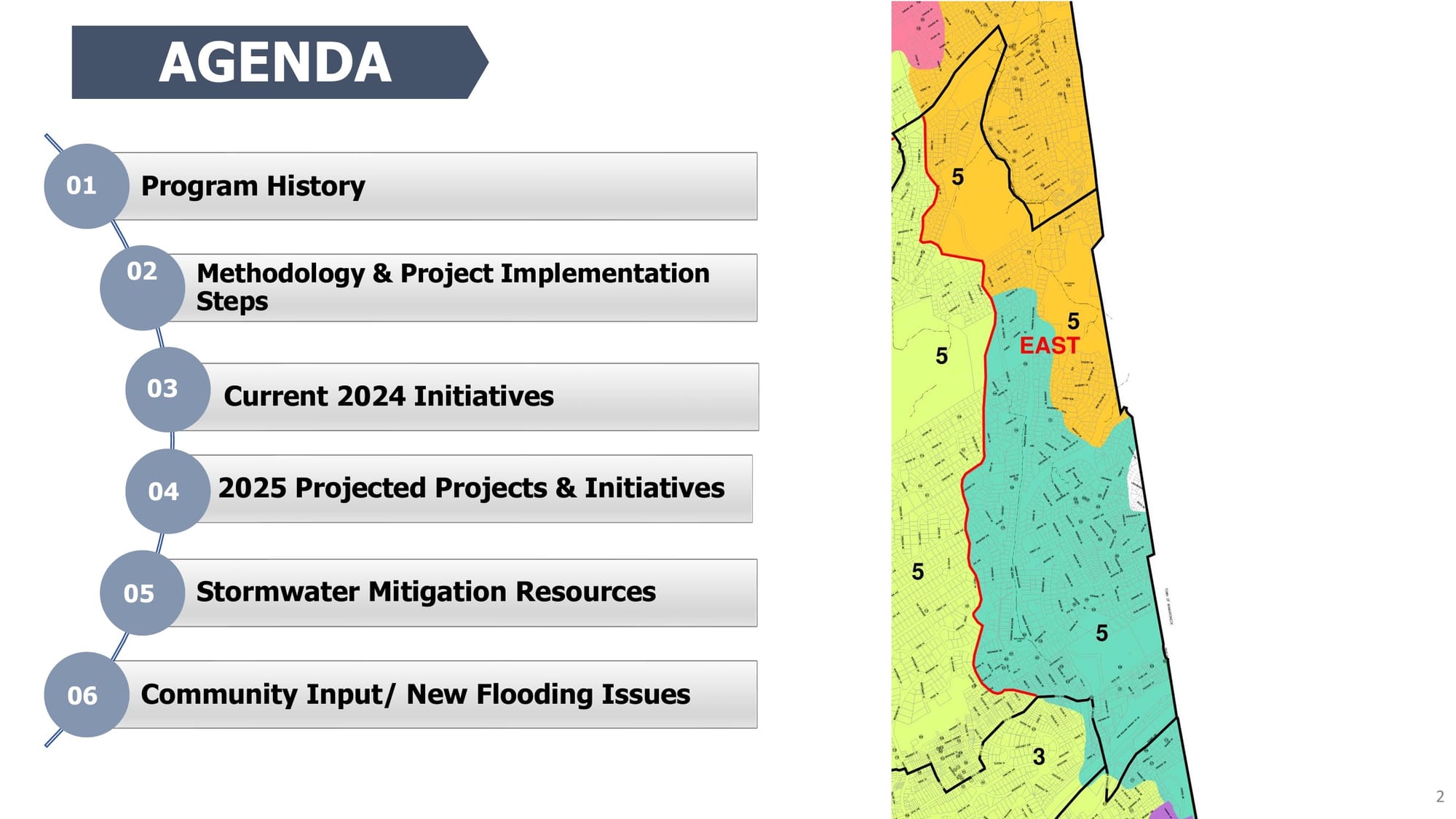

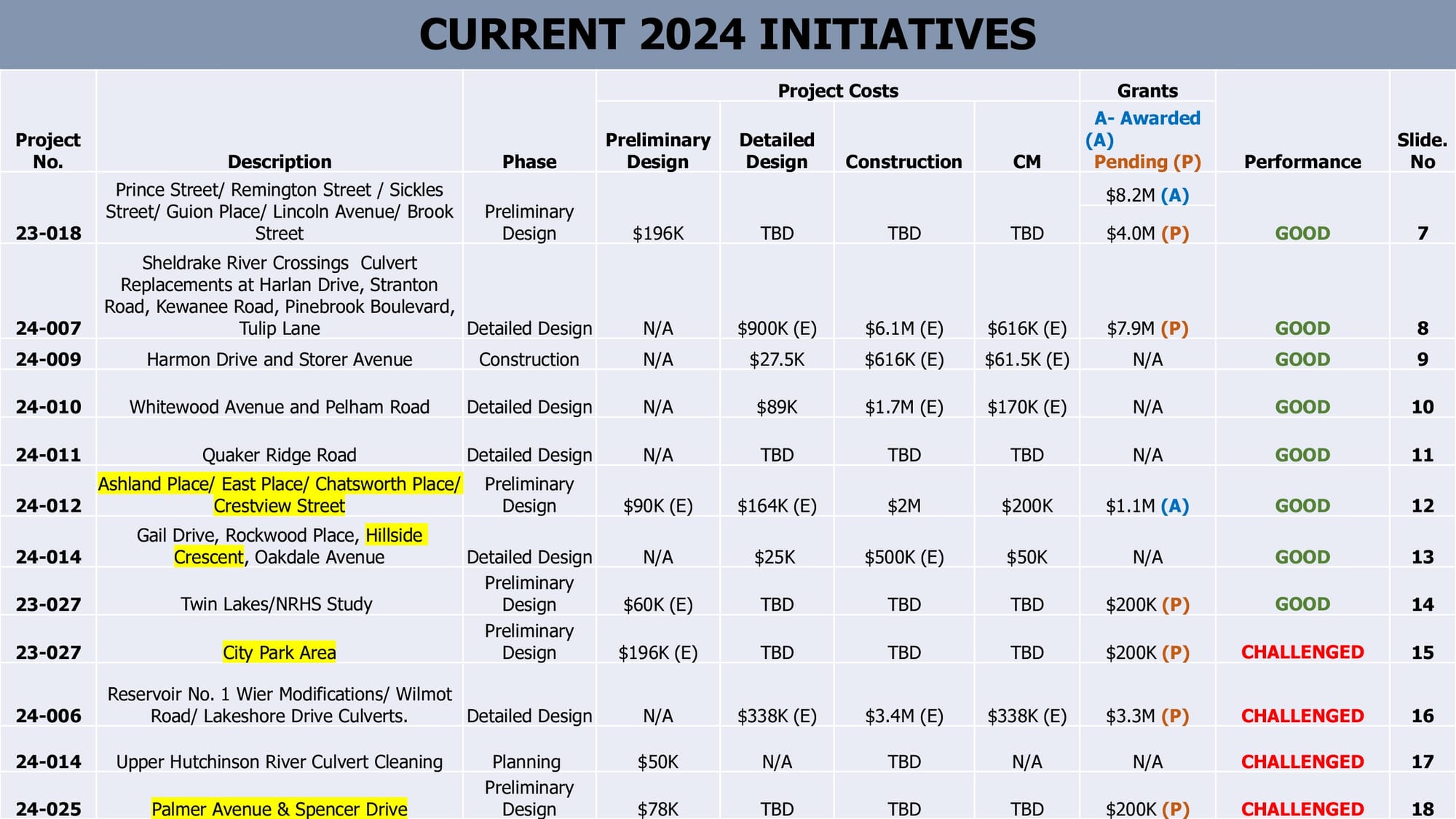
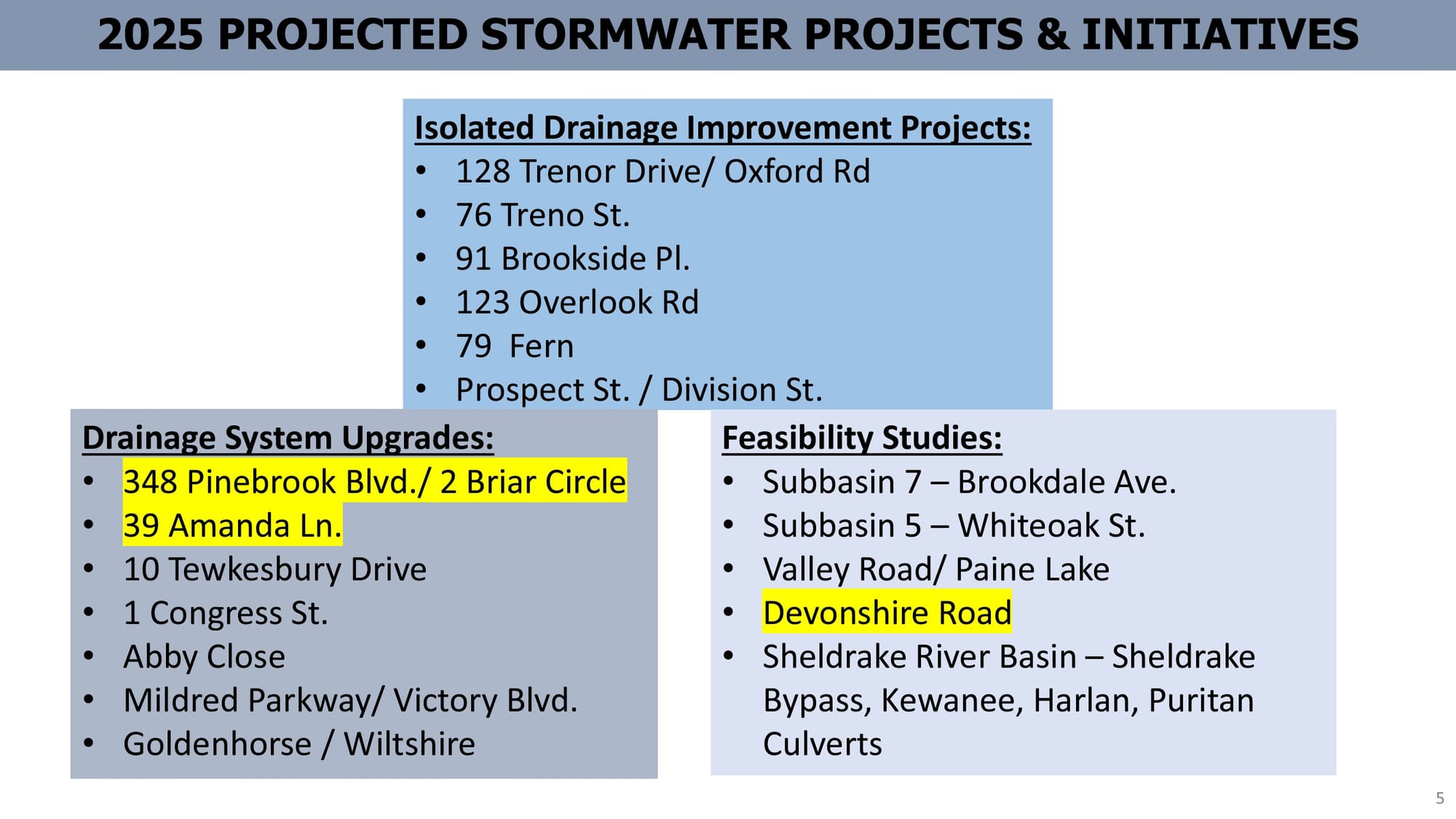



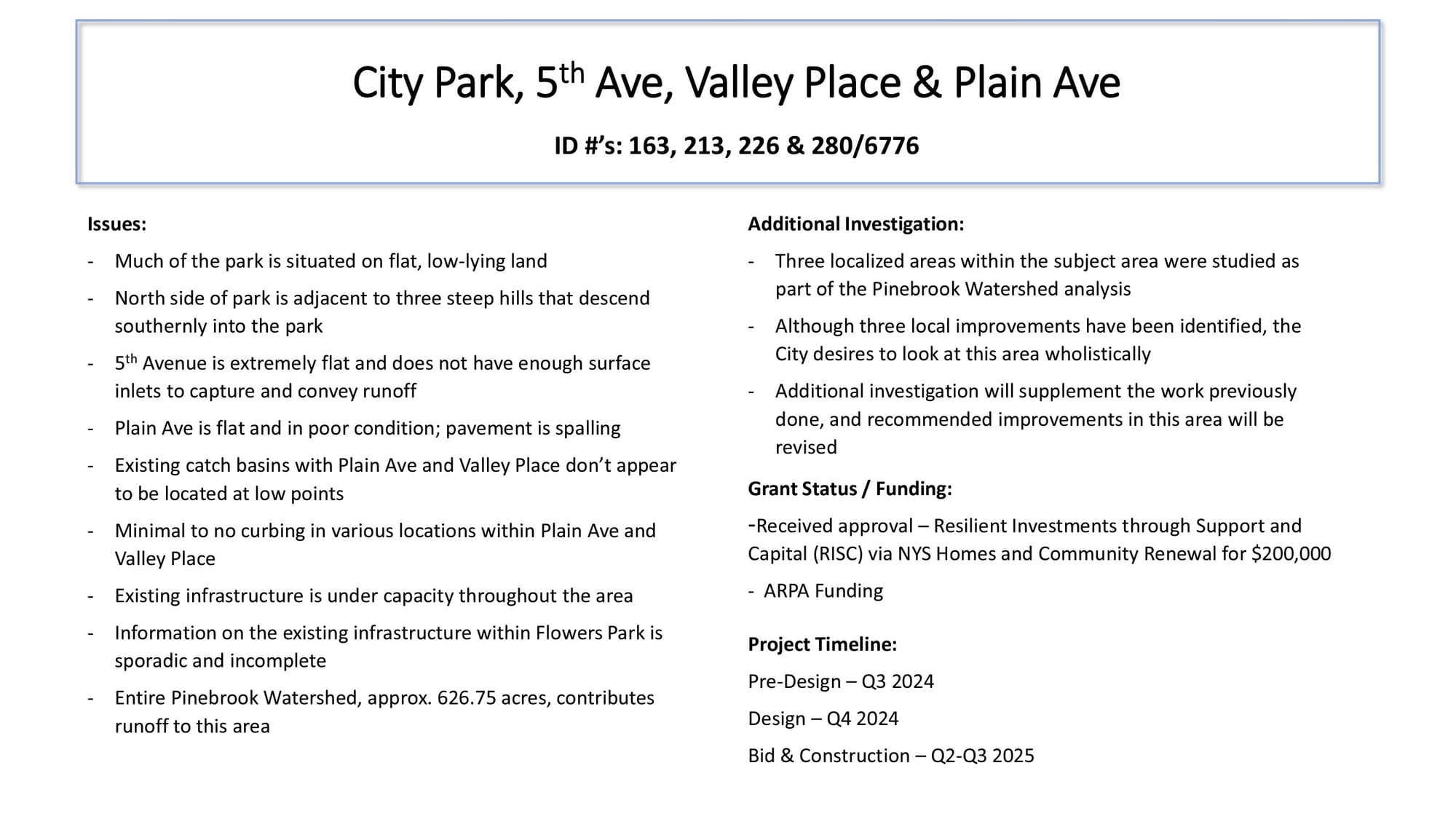
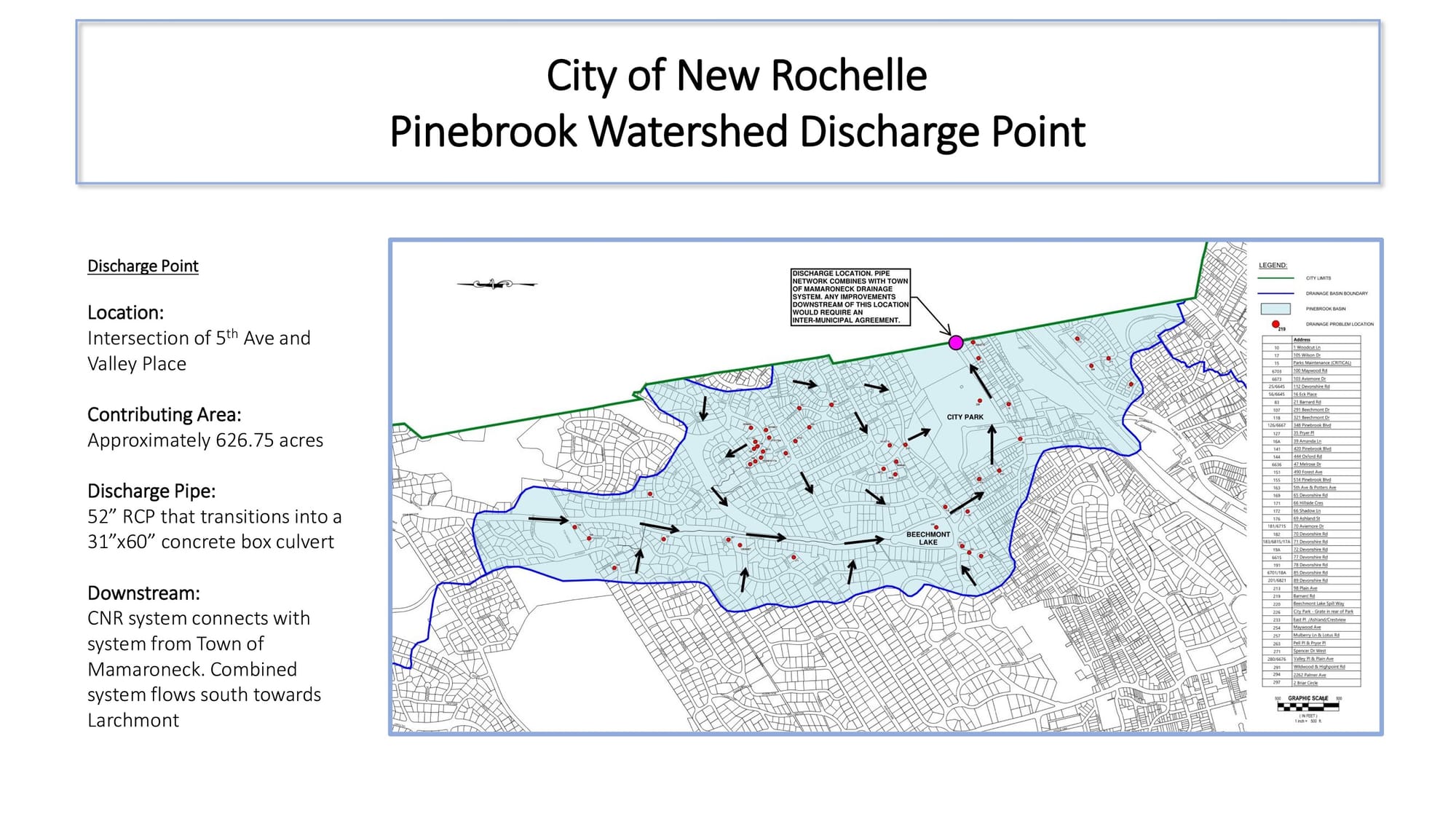
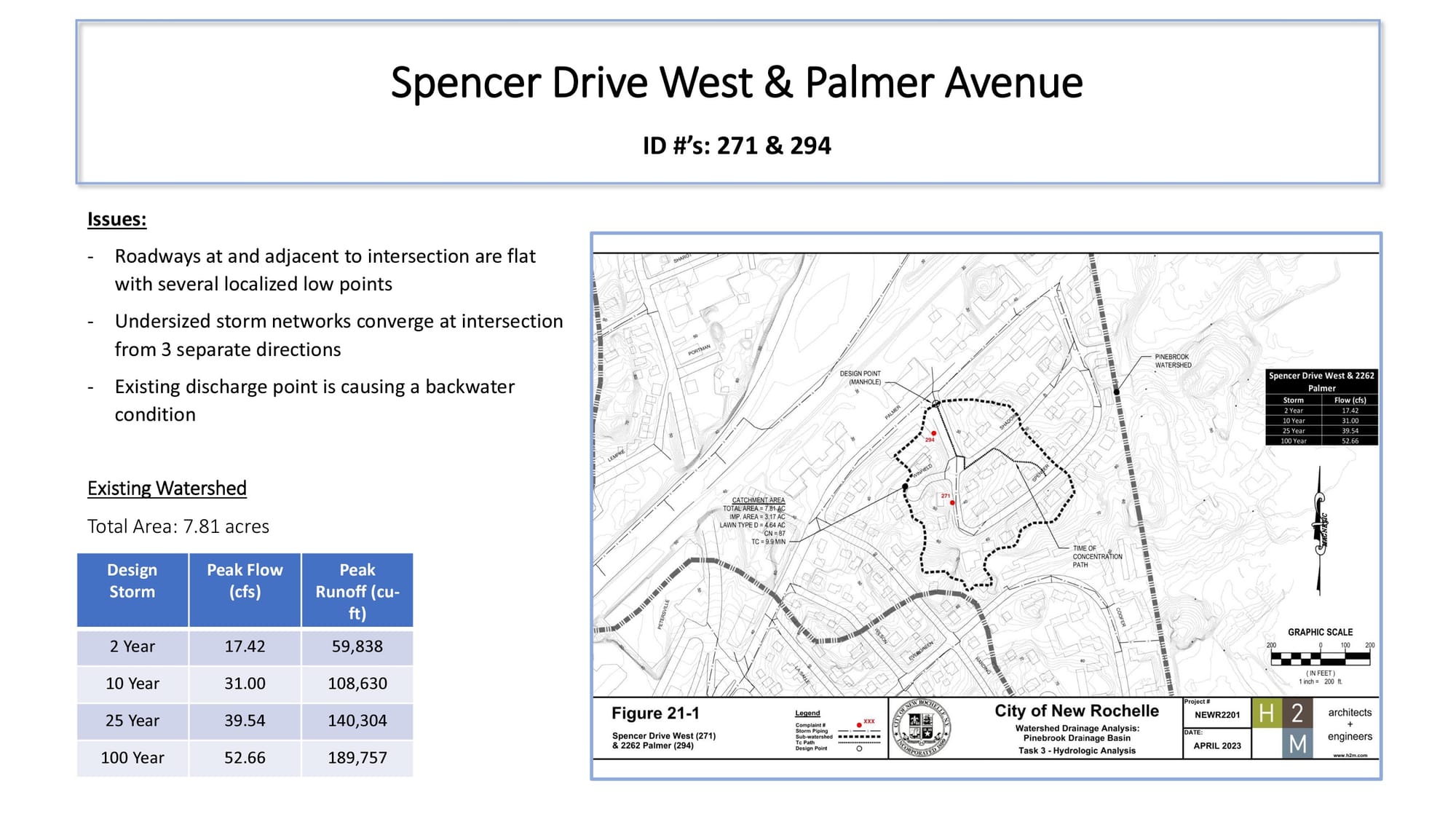
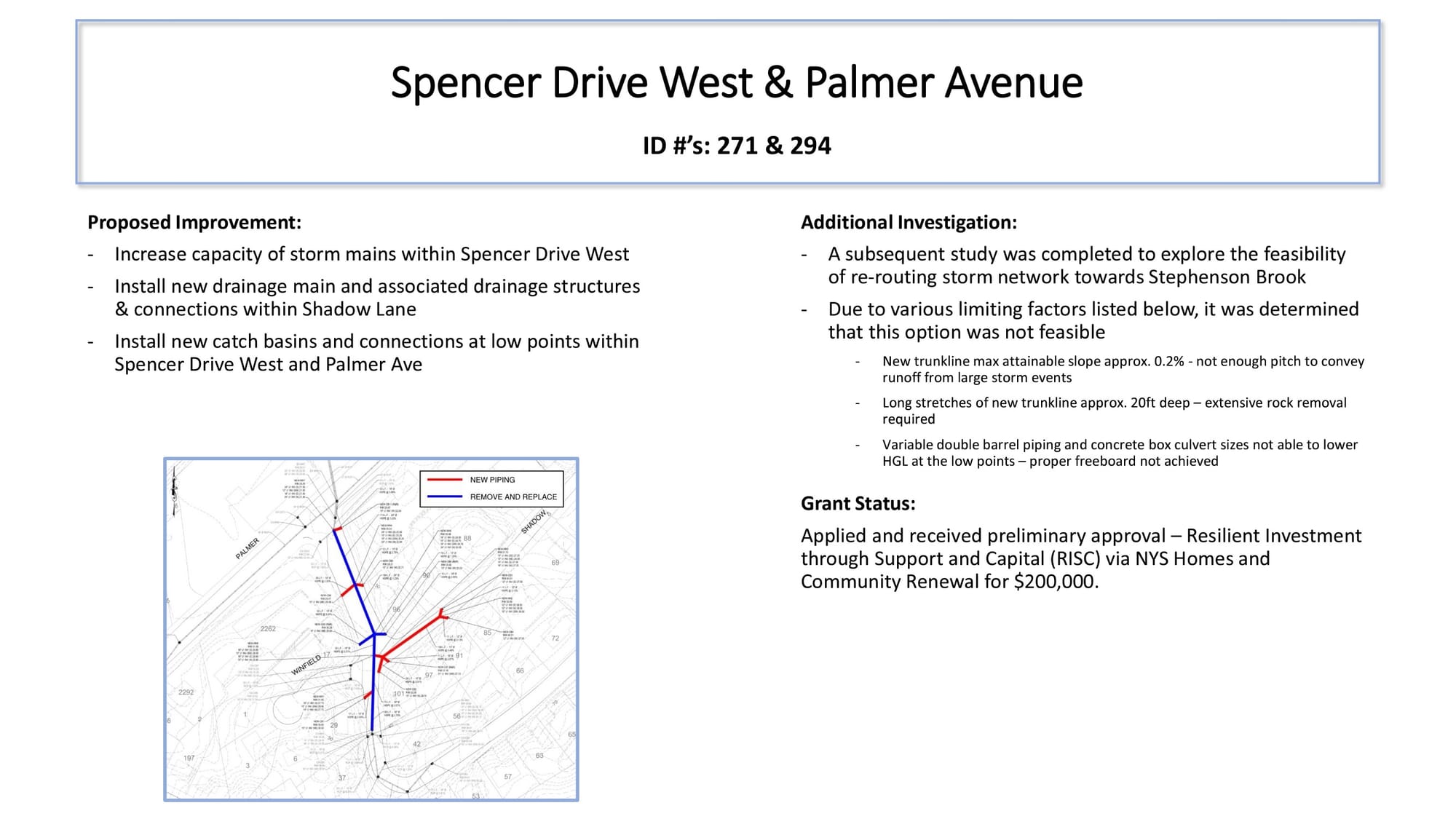
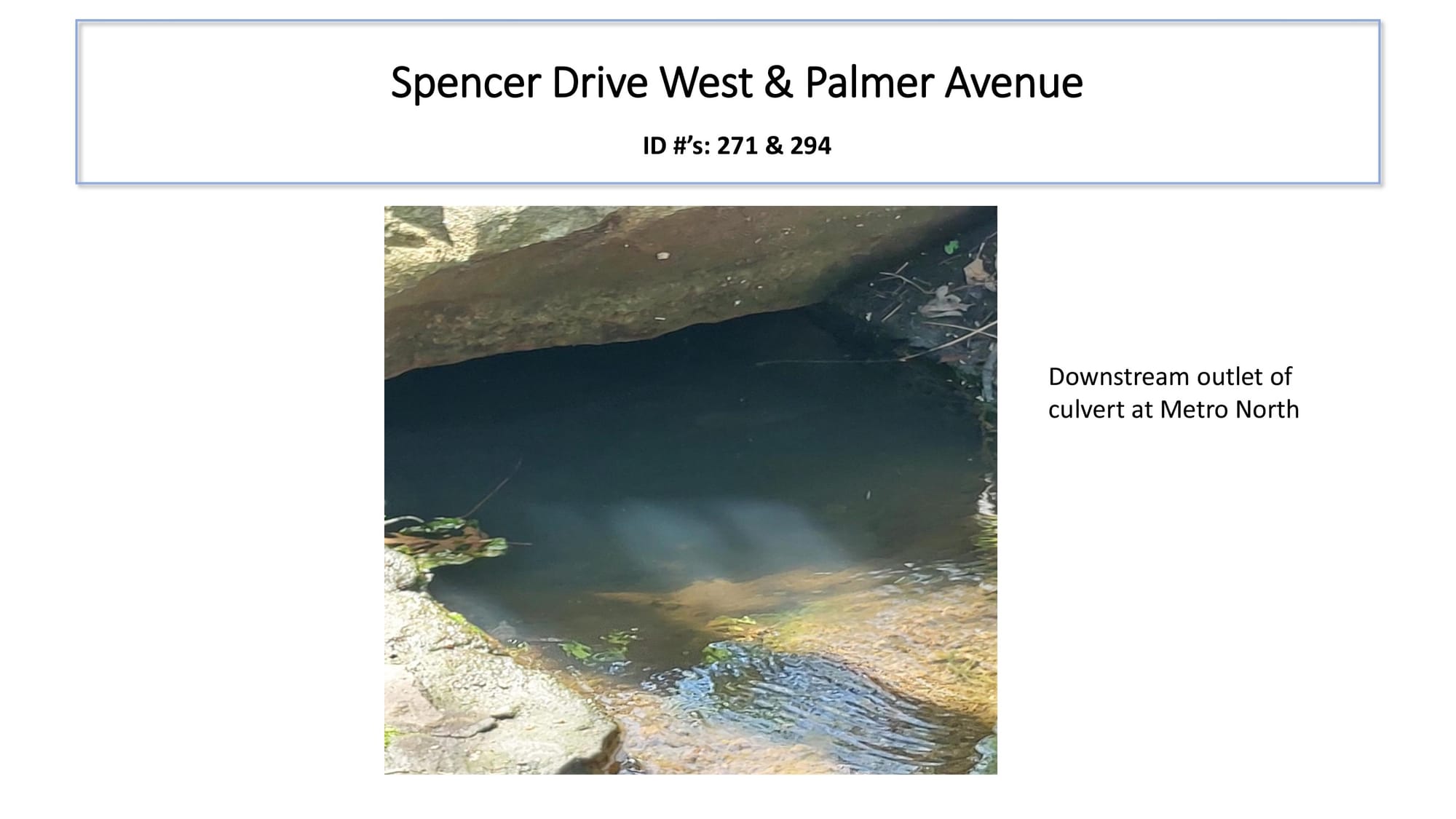
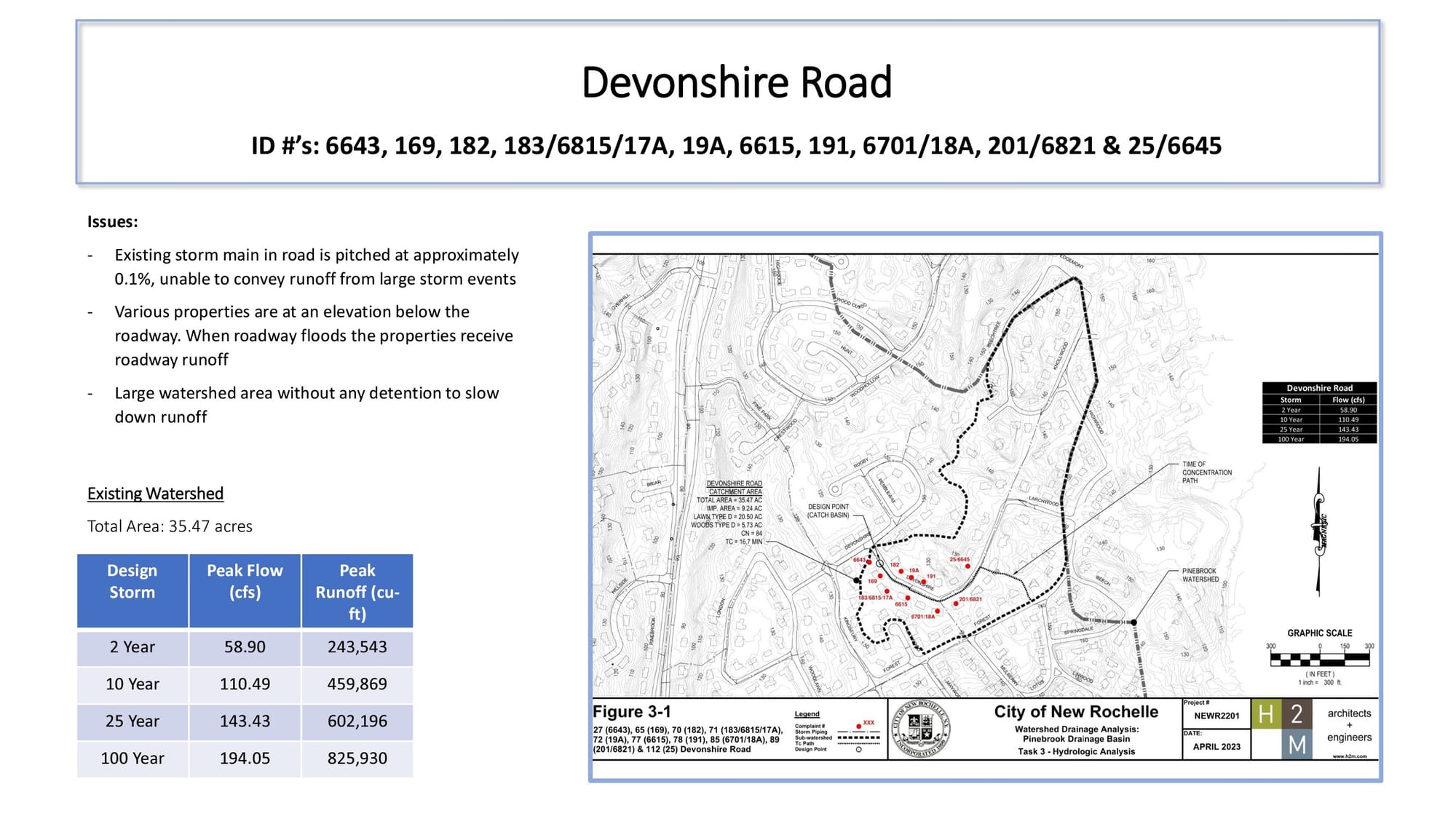
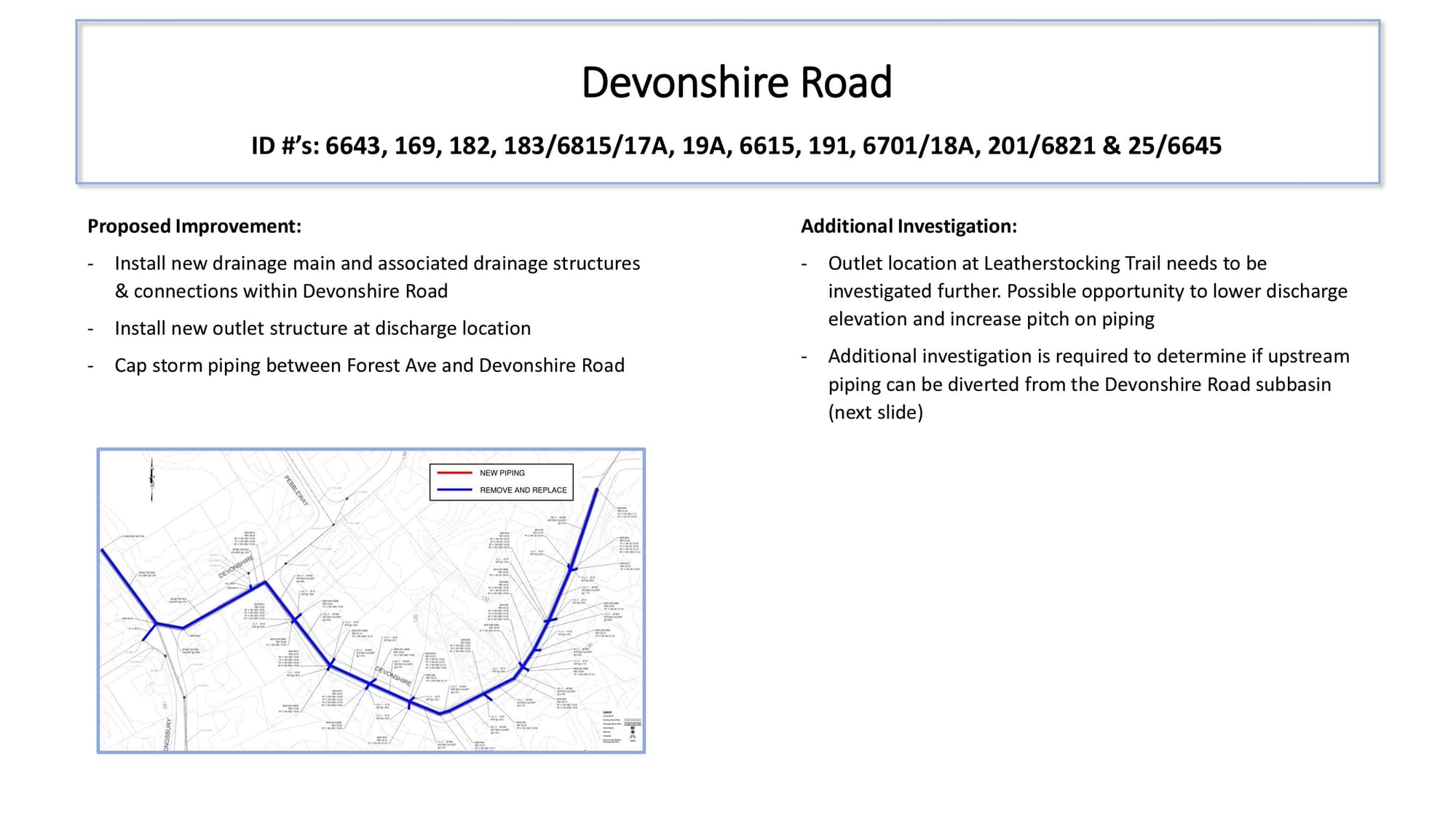
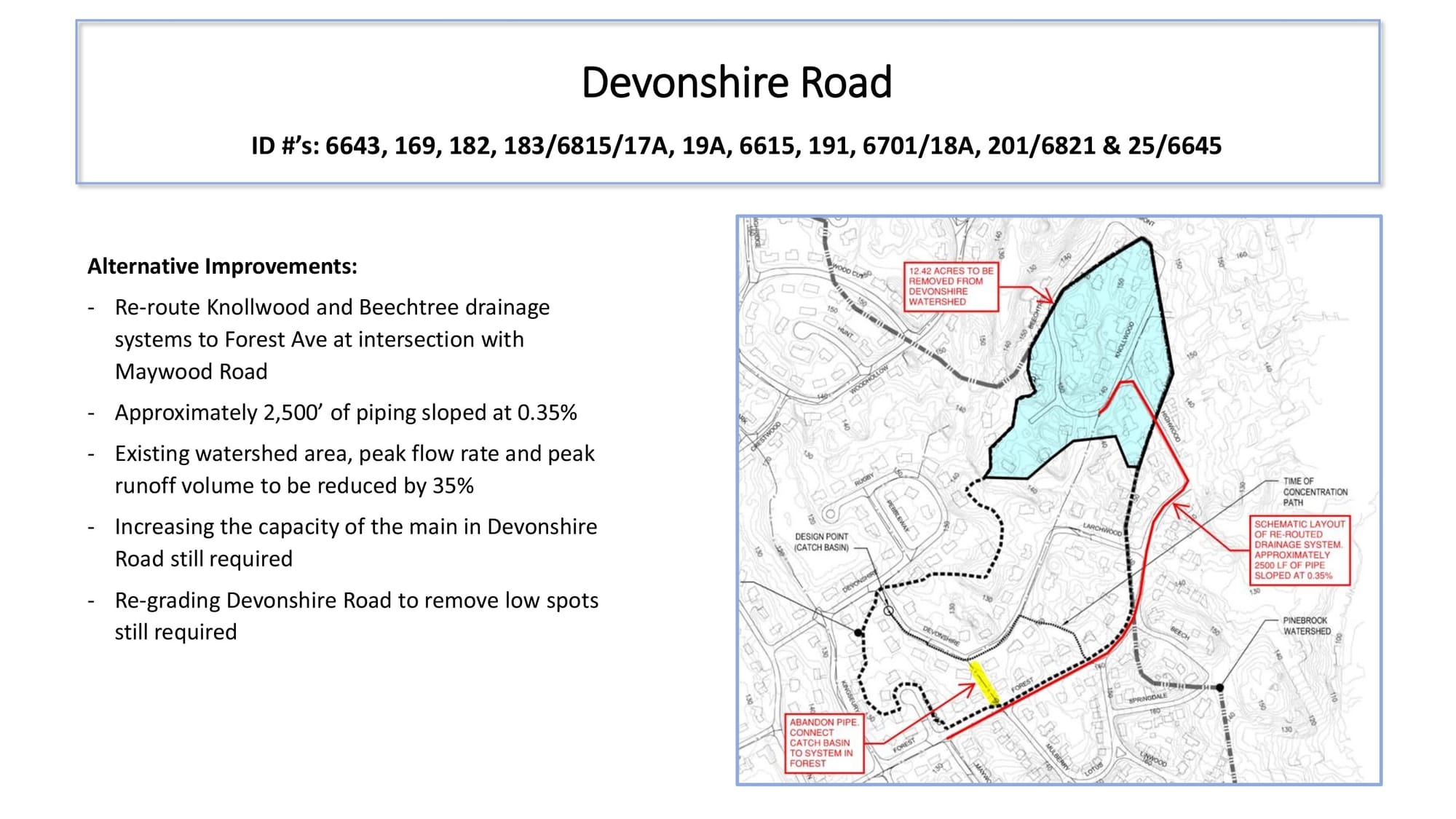
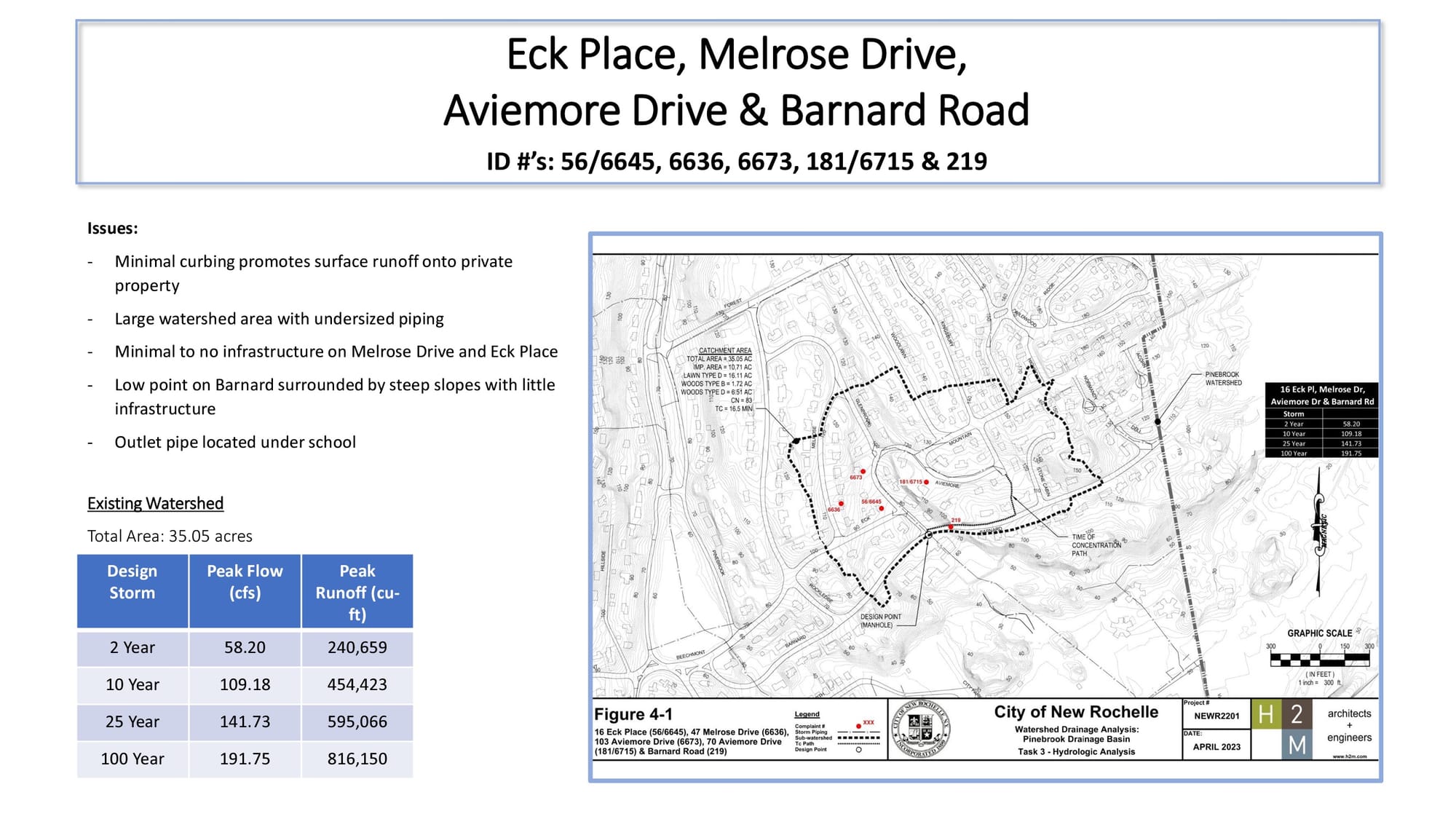

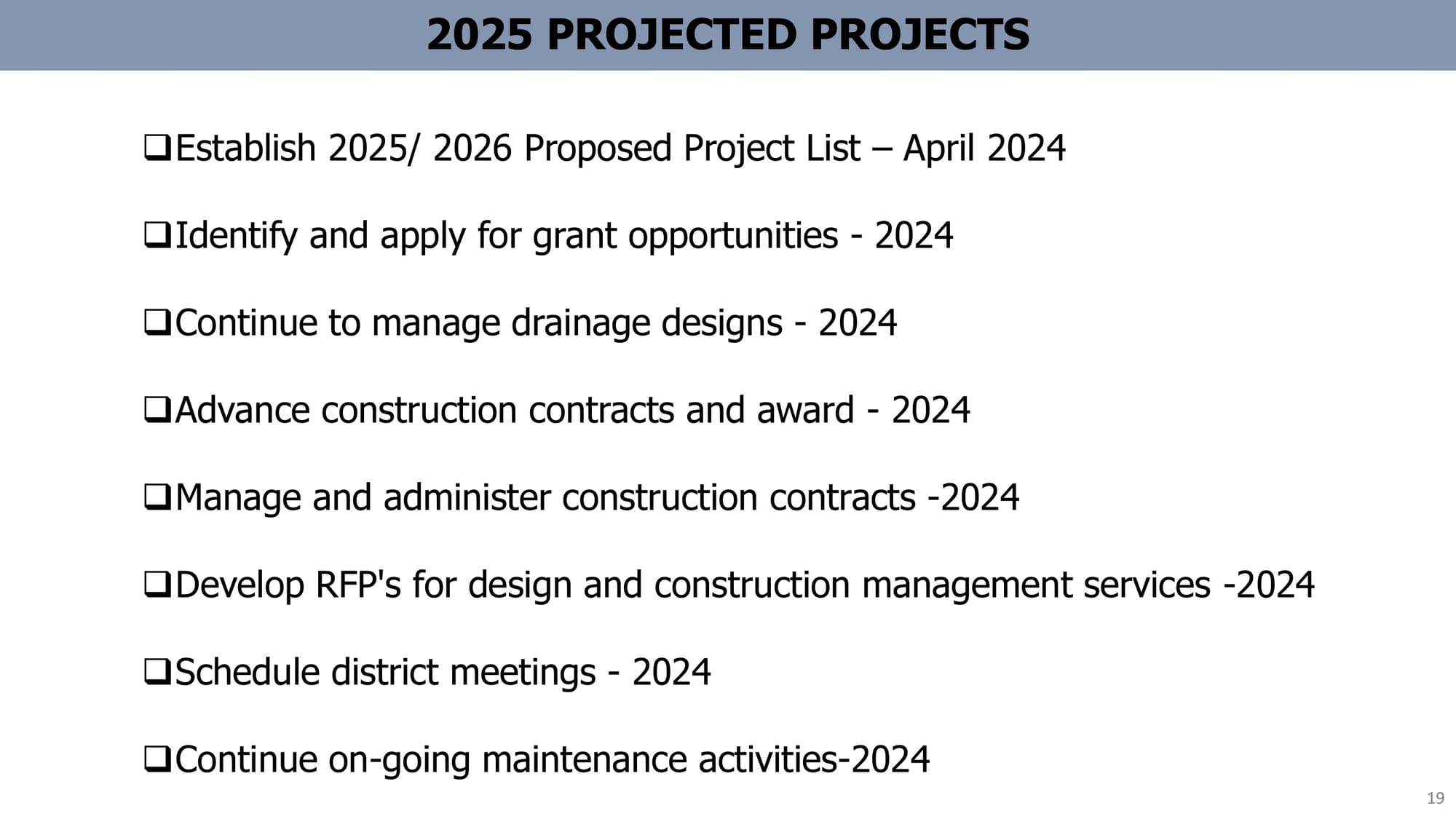

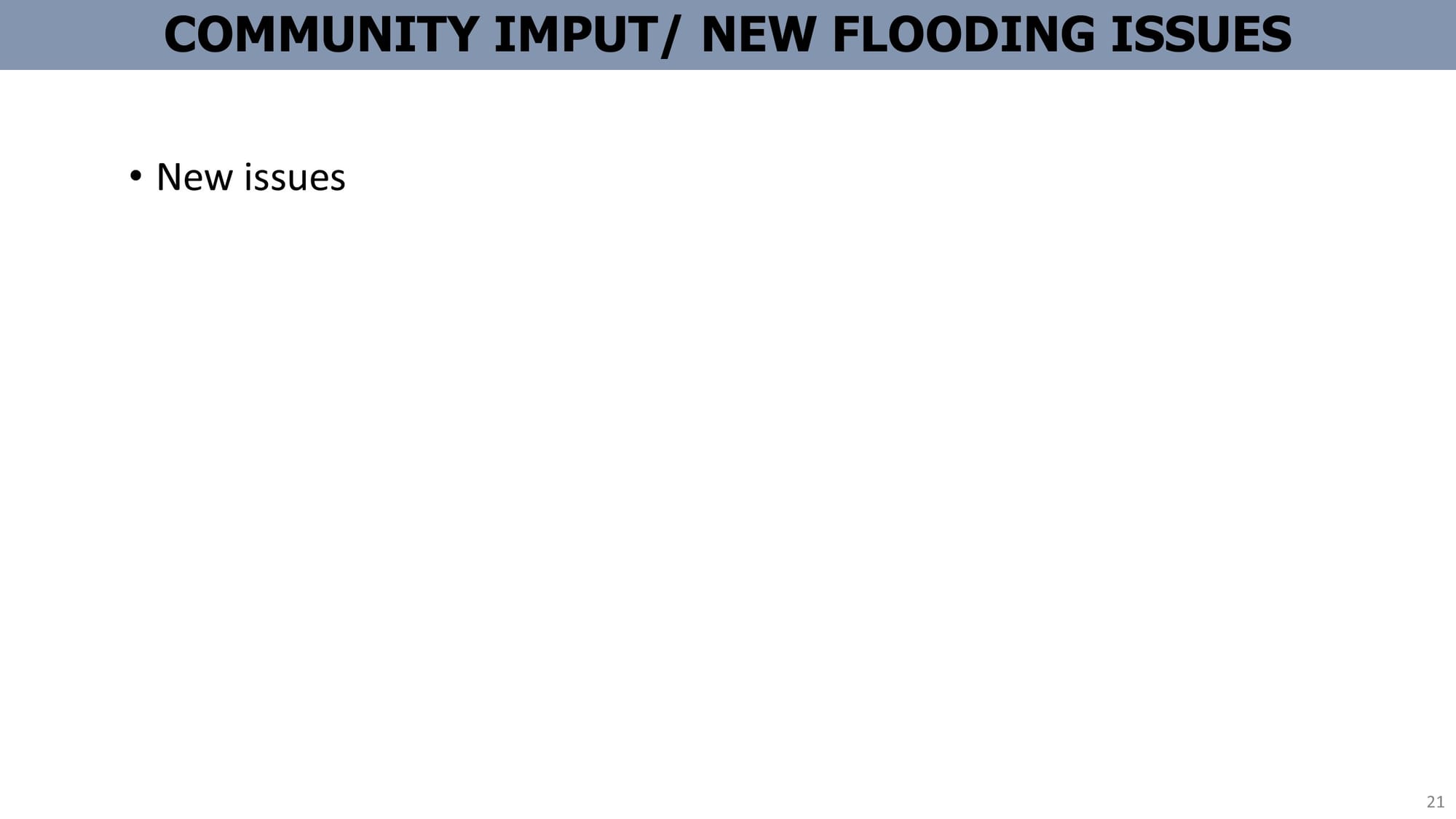

What is the Bob Young Plan?
Despite repeated requests, both City Manager Will Melendez and developer Bob Young have declined to provide me with copies of the bid documents or a site plan, making it difficult to gain a clear understanding of the proposed project. This withholding of information aligns with the secretive nature of the process, which has sparked considerable, reasonable suspicion within the community. However, through conversations with individuals who have viewed the plan, I have pieced together fragments of its contents. Below is a summary of what has been shared, though it is likely incomplete and there may be additional details.
- A multi-purpose soccer arena / concert venue
- Indoor hockey rink
- Indoor swimming pool
- Tennis courts
- Concession stands
- Community room
The plan conveniently takes, through eminent domain, the exact property described in the RFP (Ashland Street, East Place) which is a big fat red flag all but confirming a rigged bid.
Criminal Acts
Under New York State purchasing laws, a municipality cannot write a Request for Proposal that is tailored to benefit a specific plan proposed by a particular developer, as this would undermine the core principles of competitive procurement, fairness, and avoidance of favoritism. GML § 103 and § 104-b require competitive, fair procurement to prevent favoritism. RFPs must be broadly drafted to encourage open competition; tailoring to one proposal violates anti-corruption and fairness principles. Courts and the State Comptroller can invalidate biased solicitations. Municipalities must define public needs independently and award based on merit (lowest responsible bidder or best value). To legally pursue a developer-inspired idea, a municipality should first define public needs independently (e.g., via a needs assessment or public input), then issue a broad RFP inviting multiple proposals. There was no needs assessment or public input.
New York municipal officials can be criminally charged for rigging a bid. Key statutes include Penal Law § 496 (corrupting government, Class B/C felony), § 195 (official misconduct), and § 200 (bribery). GML § 103-e prohibits bid-rigging conspiracies. Violations lead to felony prosecution, prison, fines, and disqualification from office.
Cox FOIL for Bob Young Bid Proposal
Cox said on October 29:,“The deadline for submitting bids on the Flowers Park RFP has now passed. I am writing to request copies of all bid documents received. I submitted a FOIL request yesterday. However, given the strong emphasis you, the Mayor, and Council members placed last week on transparency, public engagement, and the significant public interest in this project, I ask that you either provide the bid documents to me immediately or direct staff to post them on the city website without delay. This would allow equal and simultaneous access for all interested parties.”
Melendez replied, “Please note that the requested bid proposals are not available for release at this time under POL. Since the City has not yet made an award, sharing the bid materials at this stage could affect the fairness of the ongoing process and the City’s ability to get the best value for the public. Once the selection process is complete, extensive public outreach of the proposal selected to be advanced, will be made. Once the procurement process is complete, we’ll be happy to revisit your request and provide the records as appropriate.”
In a follow-up email on November 12, Cox wrote, “Although the Freedom of Information Law (FOIL) provides that agencies may withhold certain records under exemptions like §87(2)(c), it does not require such withholding, leaving the decision to the agency’s discretion. I understand the City’s concerns regarding the ongoing procurement process and the potential implications under the Public Officers Law. To address those concerns, I am happy to accept a redacted version of the proposal at this time.
Specifically, I agree that any sections marked as “Confidential” or “Proprietary” by the bidder—as permitted in the RFP—can be withheld or redacted to protect sensitive information, such as trade secrets or financial details that could cause competitive harm. However, non-proprietary elements, including site plans, conceptual designs, project timelines, and other descriptive materials that outline the proposed redevelopment, should be releasable without impairing the process, especially given that only one proposal was received. Releasing a redacted version now would promote transparency and allow for informed public input during the evaluation phase, aligning with the City’s stated commitment to community engagement on this significant park project. I kindly ask that you reconsider and provide such a redacted copy, or if a denial is maintained, please provide a detailed explanation of why even redacted materials cannot be shared at this stage.”
The Cone of Silence
The restricted period under State Finance Law §139-j began with the public release of the RFP 5820 for the redevelopment of Flowers Park on September 12, 2025, and remains active as no decision has been made, prohibiting unauthorized communications between bidders and city officials to ensure fairness.
The RFP had no prior public engagement, drawing criticism as a “textbook case of opacity” and a “rigged game,” with council members David Peters, Albert Tarantino and Matt Stern saying they were unaware of the RFP until after it was made public. No site reviews occurred and no questions were submitted by the deadline, leading to no Q&A being posted.
The RFP designates the Deputy Finance Commissioner or representative as the sole contact for communications, with Karin Conca, Purchasing Specialist, handling submissions and pre-proposal questions, while Adam Ross serves as Deputy Finance Commissioner but is not specifically named in the RFP.
Bob Young, identified as the “lurking” developer referenced by Councilmember Albert Tarantino during an October 21, 2025, City Council meeting, is described in reports as involved in the origin of the RFP idea and part of a group of officials including Mayor Yadira Ramos, City Manager Wilfredo Melendez and Council Member Sara Kaye, aimed at privatizing the park.
Contacts with elected officials like City Council members are generally prohibited during the restricted period, though the RFP allows for city-initiated meetings with the Evaluation Committee or City Council as part of the evaluation process. Meetings with administrative officials, such as the City Manager or commissioners, are barred unless routed through designated channels or fitting exceptions like city-initiated requests for additional information.
Limiting meetings to two council members could comply with the city’s charter and Open Meetings Law by avoiding a quorum, but it does not address underlying procurement law restrictions, as all contacts must go through designated personnel.
The Evaluation Committee conducts internal evaluations without direct bidder contact, scoring proposals based on criteria including experience, approach and finances.
Violations of these rules can lead to findings of non-responsibility, debarment or contract termination.
Opposition to Bob Young Plan
Notables who do not support the plan include Assembly Members Amy Paulin and Steve Otis (the state would be involved in any alienation of park land). Westchester County Executive Ken Jenkins is against the plan. Also, what I would call the IKEA Coalition: neighborhoods around the park from Larchmont Woods, Beechmont Neighborhood, the Pinebrook Road area, Larchmont, Unincorporated Mamaroneck, Town of Mamaroneck, Village of Mamaroneck. The leadership of New Rochelle Youth Tackle Football, New Rochelle Lacrosse, Westchester Flames Soccer Club, New Rochelle Little League, and other youth sports programs. Monroe University and Iona University oppose the plan.
Council members Albert Tarantino, David Peters, Matt Stern, Sara Kaye, and Martha Lopez have publicly criticized the way the plan was rolled out. Tarantino sought to pull the RFP but was opposed 6-1.
Who Asked for the Bob Young Plan?
Several years ago, during the tenure of former Mayor Noam Bramson, developer Bob Young proposed an ambitious plan to redevelop Flowers Park—a vision that was swiftly rejected outright by city officials. According to sources, Young was representing an international soccer organization at the time. What seems evident now is that he’s not the financial powerhouse behind the current project; instead, he’s fronting for someone else, which only heightens suspicions about the true motives at play. From what I can observe, there’s no apparent demand for this in the community—no organizations have stepped forward to express support, and it lacks any endorsements. This begs the question: Who exactly is driving this revival, and which constituency stands to benefit? Notably, Young himself isn’t the one funding the effort this time, leaving the real backers and beneficiaries shrouded in mystery amid the swirling controversy.
Questions for Now — and Later
- Can you confirm that only one bid was received in response to the Flowers Park RFP, and that the sole bidder is Bob Young? If so, how does this align with the RFP’s described selection process, which anticipated narrowing down to a “final 4” before choosing a preferred developer?
- What specific “team of experts” was assembled to evaluate the bid proposal? Please provide the names and qualifications of each member. Has this team received the full bid proposal? If so, have they completed their evaluation, and did they recommend proceeding with the bid?
- If the evaluation team has recommended moving forward, will the City commit to releasing the full bid proposal—including all drawings, renderings, site plans, and financial projections—to the public before initiating negotiations for a Memorandum of Understanding (MOU)?
- How and why was the potential use of eminent domain for properties at Ashland Place and East Place incorporated into the RFP? Furthermore, how does the scope of this eminent domain provision so precisely align with elements of the submitted bid proposal, suggesting possible pre-coordination?
- Did any City officials, staff, or representatives meet or communicate with Bob Young or his associates regarding Flowers Park prior to the issuance of the RFP? If yes, please provide details on the dates, participants, and topics discussed.
- The Flowers Park RFP designates Karin Conca as the sole contact under New York State procurement law. Are there any other designated contacts for this RFP? If so, please name them, explain why they were not listed in the RFP, and describe the legal process by which they were added, ensuring compliance with state procurement guidelines.
- Will the City release a complete log of all contacts, communications, and meetings with Bob Young or his representatives related to the Flowers Park project, in accordance with New York State’s Procurement Lobbying Law requirements.
- If the proposed redevelopment transforms Flowers Park into an expanded, world-class, year-round sports facility, what traffic impact studies have been conducted to assess increased congestion, particularly on weekends when the area is already crowded? Additionally, how will parking demands be addressed, including projections for additional vehicles and any planned infrastructure expansions?
- What is the underlying business model for this public-private partnership? Specifically, what revenue streams are anticipated (e.g., user fees, concessions, event hosting), and how will the City ensure that any profits are equitably shared while maintaining affordable access for community organizations and low-income residents?
- Under New York State’s Eminent Domain Procedure Law (EDPL), eminent domain must serve a clear public purpose and involve good-faith negotiations. How does the RFP’s inclusion of eminent domain meet these criteria, particularly if the primary driver appears to be economic development rather than essential public need? Has a comprehensive economic development plan been prepared as potentially required under pending legislation like Senate Bill S6187?
- Given the RFP’s emphasis on a “world-class Community Sports Complex,” what environmental impact assessments have been or will be conducted under the State Environmental Quality Review Act (SEQRA)? How will the project mitigate potential issues like increased stormwater runoff, loss of green space, or habitat disruption in this park-like setting?
- Why has this proposal been revived now, despite its outright rejection several years ago under former Mayor Noam Bramson? What has changed in terms of community needs, market conditions, or legal frameworks to justify reconsidering a plan that was previously deemed unsuitable?
- To address concerns about potential conflicts of interest, can the City confirm that no officials, staff, or their immediate family members have any financial ties, past or present, to Bob Young, his affiliated organizations, or any potential funding sources behind the bid?
- Since the RFP process has been criticized for lacking transparency, including by a majority of council, how does the City plan to ensure compliance with New York State Procurement Guidelines for public-private partnerships, including competitive bidding requirements and public oversight by entities like the State Comptroller?
- What safeguards are in place to guarantee that Flowers Park remains publicly owned and accessible, as stated in City communications? For instance, will any MOU or final agreement include enforceable clauses preventing privatization, excessive fee structures, or restrictions on community use?
- Under the terms of the proposed public-private partnership, who will hold legal title to any new buildings, facilities, or structures constructed on Flowers Park property? If the developer or an affiliated entity gains ownership or long-term control, what restrictions, if any, will be imposed on their ability to sell, transfer, lease, or repurpose these assets in the future—such as after five years—and how does this align with the City’s assurances of maintaining public ownership.
RELATED
Yadira & Co. Gaslighting on New Rochelle’s Flowers Park (an 8-Part Series)
- Yadira & Co. Gaslighting on New Rochelle’s Flowers Park - Part I(10/26/2025)
- Yadira & Co. Gaslighting on New Rochelle’s Flowers Park - Part II(10/27/2025)
- Yadira & Co. Gaslighting on New Rochelle’s Flowers Park - Part III(10/28/2025)
- Yadira & Co. Gaslighting on New Rochelle’s Flowers Park - Part IV(10/28/2025)
- Yadira & Co. Gaslighting on New Rochelle’s Flowers Park - Part V(10/28/2025)
- Yadira & Co. Gaslighting on New Rochelle’s Flowers Park - Part VI(10/28/2025)
- Yadira & Co. Gaslighting on New Rochelle’s Flowers Park - Part VII(10/30/2025)
- Yadira & Co. Gaslighting on New Rochelle’s Flowers Park - Part VIII(10/30/2025)
- Yadira & Co. Gaslighting on New Rochelle’s Flowers Park (an 8-Part Series)
Bonus Coverage
Yadira & Co. Gaslighting on New Rochelle’s Flowers Park - Part IX
Past Articles and Documents
- New Rochelle Flowers Park RFP Was Plagiarized from Pelham Picture House RFP (10/22/2025)
- New Rochelle Council Discussion of Flowers (City) Park Gets Heated(10/21/2025)
- New Rochelle City Council to Discuss Master Developer RFP to Reimagine Flowers (City) Park (10/21/2025)
- New Rochelle Issues Statement on Controversial Flowers (City) Park RFP (10/17/2025)
- New Rochelle Has Spoken: Hands Off Flowers Park (10/16/2025)
- New Rochelle’s Last Stand: Fight Flowers Park Privatization at Urgent Council Hearing Wednesday(10/14/2025)
- New Rochelle Looks to Put Flowers Park Under Control of a Master Developer (9/14/2025)
- Master Developer RFP Specification No. 5820 (9/12/2025)
- 5816 – Drainage Improvements at Ashland St and East Pl(8/22/2025)
- 5719 – Drainage Improvements at City Park (10/23/2024)
- New Rochelle Looks to Put Flowers Park Under Control of a Master Developer (9/14/2025)
- New Rochelle Has Spoken: Hands Off Flowers Park (10/16/2025)
- New Rochelle Drainage Analysis Study (2023)
- Pinebrook Water Shed Analysis (2023)
- Pinebrook Water Shed Analysis: Appendix R (2023)


